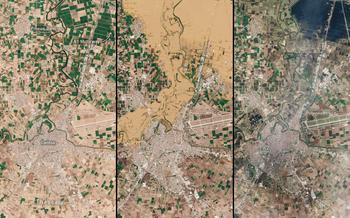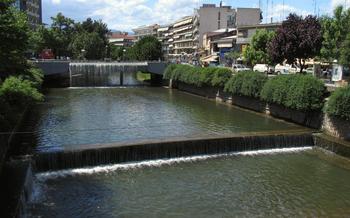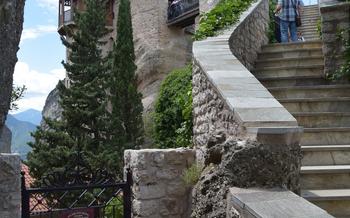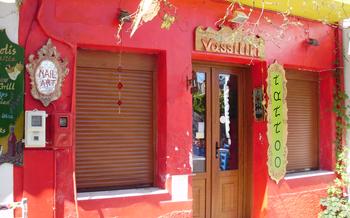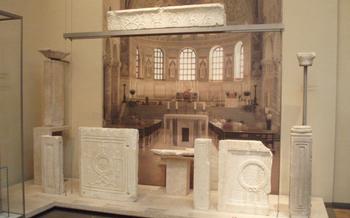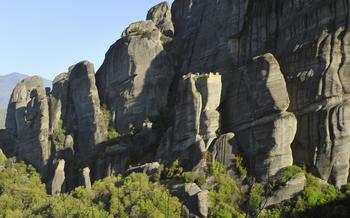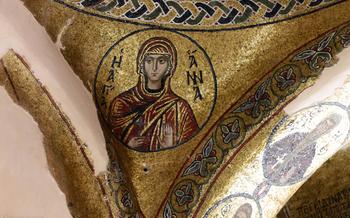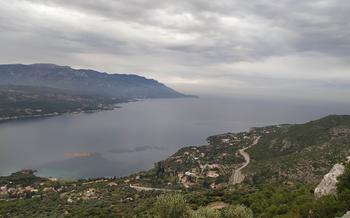
The Monasteries of Meteora
- A Journey to the Summit: Discovering the Monasteries of Meteora
- A Scenic Drive Through the Plains of Thessaly
- A Marvel of Architecture: The Monastery of Great Meteoron
- A Holy Retreat: The Monastery of Varlaam
- A Journey Through Time: The Monastery of Rousanou
- A Glimpse of Heaven: The Monastery of St. Stephen
- A Journey of Faith: The Monastery of Ypapanti
- A Place of Serenity: The Monastery of Holy Trinity
- A Path Through History: The Monastery of St. Nicholas Badovas
- A Journey of Discovery: The Monastery of Kalampaka
- Hiking and Exploring the Meteora Region
- A Taste of Tradition: Local Cuisine and Delicacies
- Meteora's Rich History and Culture: A Journey Through Time
- Insider Tip: Plan Your Visit and Embrace the Experience
A Journey to the Summit: Discovering the Monasteries of Meteora
Perched atop towering rock formations, the Monasteries of Meteora stand as testaments to human ingenuity and spiritual devotion. Built between the 14th and 16th centuries, these architectural marvels were once home to a thriving monastic community seeking refuge from worldly distractions and pursuing a life of contemplation and prayer. Today, they welcome visitors from around the world, offering a glimpse into a bygone era and a chance to marvel at the stunning natural beauty of the Thessalian landscape.
The unique geology of the Meteora rock formations, known as "meteora," played a crucial role in the monasteries' construction. These towering pillars of sandstone and conglomerate, formed millions of years ago by the erosion of ancient riverbeds, provided a natural defense against invaders and a secluded environment for the monks. The monasteries were built using ingenious techniques, with materials transported up the steep cliffs using ropes and pulleys. Each monastery is a testament to the unwavering faith and determination of the monks who dedicated their lives to building these architectural wonders.
The religious significance of the Meteora monasteries is profound. They were founded during a time of great spiritual upheaval, when the Byzantine Empire was in decline and the Ottoman Turks were expanding their influence in the Balkans. The monks sought solace and refuge in these remote monasteries, where they could devote themselves to prayer and worship. Over the centuries, the monasteries became important centers of Orthodox Christianity, attracting pilgrims from across the region.
Reaching the monasteries was no easy task, requiring a challenging climb up steep paths and narrow staircases carved into the rock. The journey was often perilous, with visitors relying on ropes and ladders to navigate the treacherous terrain. In the past, the monasteries were accessible only to men, but today, women are also welcome to visit. The effort required to reach these sacred spaces adds to the sense of awe and wonder that visitors experience upon arrival.
A Scenic Drive Through the Plains of Thessaly
A scenic drive through the vast and fertile plains of Thessaly offers a captivating journey through Greek history, mythology, and culinary delights. Surrounded by the majestic Pindos Mountains and the shimmering Aegean Sea, this region is a tapestry of natural beauty, ancient ruins, and charming villages.
Thessaly, the largest region in mainland Greece, is renowned for its agricultural prowess and its role as the breadbasket of the country. As you traverse the verdant plains, you'll encounter rolling hills, olive groves, vineyards, and fields of wheat swaying in the breeze.
The region boasts a rich historical legacy, dating back to the Bronze Age. It was here that the powerful kingdom of Thessaly flourished, leaving behind impressive archaeological sites such as the ancient city of Dimini and the Mycenaean fortress of Sesklo.
As you drive through the Thessalian countryside, you'll stumble upon quaint traditional villages that have preserved their timeless charm. Stop by one of these villages to experience the authentic Greek way of life. Stroll through the narrow cobblestone streets, admire the whitewashed houses adorned with colorful flowers, and indulge in the warm hospitality of the locals.
Make sure to savor the flavors of Thessalian cuisine, which showcases the region's fresh produce and unique culinary traditions. Sample the delicious cheeses, hearty stews, and succulent grilled meats. Don't miss the opportunity to visit a local winery and taste the renowned wines produced in the region.
The drive through Thessaly is an unforgettable experience that combines stunning scenery, historical wonders, and culinary delights. Embrace the beauty and tranquility of this region as you journey towards the awe-inspiring monasteries of Meteora.
A Marvel of Architecture: The Monastery of Great Meteoron
Perched atop a towering rock pinnacle, the Monastery of Great Meteoron stands as a testament to human ingenuity and faith. Its construction, dating back to the 14th century, involved an arduous process of transporting materials up the sheer cliffs. The monastery's design reflects a harmonious blend of Byzantine and Ottoman influences, showcasing intricate stone carvings, vaulted ceilings, and elegant arches.
Inside the monastery, visitors are greeted by a stunning collection of Byzantine art and manuscripts. The frescoes adorning the walls and ceilings depict vivid scenes from the Bible and the lives of the saints, offering a glimpse into the rich artistic heritage of the region. Among the highlights is the "Last Judgment" fresco, a masterpiece of Byzantine iconography that portrays the celestial realm in all its grandeur.
The monastery's balconies offer breathtaking views of the surrounding landscape. From these vantage points, visitors can gaze upon the majestic peaks of the Pindus Mountains, the vast expanse of the Thessalian plains, and the meandering Pineios River. The panorama is a testament to the natural beauty of the Meteora region, a place where faith and nature intertwine to create a truly awe-inspiring spectacle.
A Holy Retreat: The Monastery of Varlaam
Perched on a towering pinnacle of rock, the Monastery of Varlaam stands as a beacon of spirituality and tranquility amidst the stunning Meteora landscape. Founded in the 16th century by the monk Varlaam, the monastery is renowned for its unique frescoes and iconography, which adorn the walls of its interior. Depicting biblical scenes and the lives of saints, these vibrant and expressive artworks offer a glimpse into the rich religious heritage of the Meteora monasteries.
Beyond its artistic treasures, the Monastery of Varlaam exudes a palpable sense of peace and serenity. Visitors are invited to explore the monastery's tranquil courtyards, where the sound of birdsong and the gentle breeze create a meditative atmosphere. The monastery's monks, known for their hospitality and warmth, welcome visitors with open arms, sharing stories of their faith and the history of their sacred abode.
As the sun begins to set, the Monastery of Varlaam transforms into a magical sight. The warm glow of the setting sun illuminates the monastery's stone facades, casting long shadows across the surrounding landscape. From the monastery's balconies, visitors can witness breathtaking views of the Meteora region, where the towering rock formations seem to glow with an ethereal light.
A Journey Through Time: The Monastery of Rousanou
Perched on a towering rock pinnacle, the Monastery of Rousanou stands as a testament to the architectural prowess of the Meteora monks. Founded in the 16th century, this awe-inspiring monastery boasts a rich history, having undergone several expansions and renovations over the centuries. Visitors will be captivated by its intricate architectural elements, including its beautifully arched doorways, decorative cornices, and elegant bell tower.
Inside the monastery, a treasure trove of religious artifacts and relics awaits discovery. From intricately carved wooden iconostases to ancient manuscripts and rare icons, Rousanou houses a significant collection of sacred objects that provide a glimpse into the monastery's spiritual heritage. As you wander through its corridors and chambers, you'll feel a sense of reverence and awe, surrounded by the tangible remnants of past generations of monks who dedicated their lives to faith.
But what truly sets Rousanou apart is its breathtaking panoramic views. From the monastery's terrace, visitors can feast their eyes on an unparalleled vista of the surrounding Meteora region. The towering rock formations, lush valleys, and distant mountain ranges create a landscape of unparalleled beauty, inviting you to immerse yourself in the splendor of nature's masterpieces. Whether you choose to gaze out at the sunrise, sunset, or the starlit sky, the views from Rousanou are sure to leave an everlasting impression.
A Glimpse of Heaven: The Monastery of St. Stephen
Perched atop a towering pinnacle of rock, the Monastery of St. Stephen stands as a testament to the architectural prowess and spiritual devotion of the monks who built it. Its history is shrouded in mystery, with legends attributing its foundation to a miraculous intervention by the Virgin Mary. The monastery's interior is adorned with stunning frescoes and artwork, depicting scenes from the Bible and the lives of the saints. The atmosphere within the monastery is one of tranquility and peace, inviting visitors to reflect and connect with their spiritual side. From the monastery's balconies, visitors are rewarded with panoramic views of the surrounding Meteora region, a breathtaking spectacle that leaves them in awe of the beauty of this sacred place.
A Journey of Faith: The Monastery of Ypapanti
Perched on a towering rock pinnacle, the Monastery of Ypapanti stands as a testament to the enduring power of faith. Its origins can be traced back to the 13th century, when a group of devout monks sought refuge in the Meteora region. Over the centuries, the monastery has undergone several renovations and expansions, each leaving its mark on the architectural tapestry of the complex.
Visitors to the Monastery of Ypapanti are greeted by a serene and welcoming atmosphere. The monastery's whitewashed walls and red-tiled roofs blend seamlessly with the surrounding landscape, creating a harmonious unity with nature. Inside, the monastery's chapel is adorned with exquisite frescoes and iconography, depicting biblical scenes and the lives of saints. The intricate details and vibrant colors of the artwork transport visitors to a realm of divine beauty and inspiration.
Beyond its artistic treasures, the Monastery of Ypapanti holds immense spiritual significance. The monastery's monks have dedicated their lives to prayer, contemplation, and the pursuit of spiritual enlightenment. Visitors are invited to join the monks in their daily prayers and services, experiencing the profound sense of peace and tranquility that permeates the monastery's sacred spaces.
The Monastery of Ypapanti also offers breathtaking views of the surrounding Meteora region. From the monastery's balconies, visitors can gaze upon the awe-inspiring panorama of towering rock formations, lush valleys, and distant mountains. The monastery's unique vantage point provides a truly unforgettable experience, allowing visitors to connect with the natural beauty and spiritual essence of Meteora.
A Place of Serenity: The Monastery of Holy Trinity
Nestled amidst the towering rock formations of Meteora, the Monastery of Holy Trinity stands as a beacon of spirituality and tranquility. Its history dates back to the 14th century, when it was founded by a group of devout monks seeking refuge and communion with the divine. Over the centuries, the monastery has undergone numerous renovations and expansions, each contributing to its architectural grandeur and spiritual significance.
The architectural elements of the Monastery of Holy Trinity are a testament to the skill and dedication of its builders. The main church, with its intricate frescoes and iconography, is a masterpiece of Byzantine art. The vaulted ceilings, supported by slender columns, create a sense of awe and inspiration. The monastery's balconies offer breathtaking views of the surrounding landscape, inviting visitors to contemplate the beauty of the natural world and the grandeur of the divine.
Within the monastery's walls, a collection of religious artifacts and relics holds great significance for pilgrims and visitors alike. These treasures, including ancient manuscripts, icons, and sacred objects, offer a glimpse into the rich history and traditions of the Orthodox Christian faith. The spiritual atmosphere of the monastery is palpable, inviting visitors to find solace, reflection, and a deeper connection with their inner selves.
A Path Through History: The Monastery of St. Nicholas Badovas
Nestled amidst the awe-inspiring rock formations of Meteora, the Monastery of St. Nicholas Badovas stands as a testament to the region's rich history and spiritual heritage. Founded in the 14th century, the monastery is believed to be one of the oldest in Meteora, with its origins shrouded in mystery and intrigue.
Architectural Marvels and Hidden Treasures The Monastery of St. Nicholas Badovas boasts a unique architectural style that blends traditional Byzantine elements with later additions and modifications. As you approach the monastery, you will be struck by its imposing entrance, adorned with intricate carvings and frescoes that hint at the treasures within.
Inside the monastery, you will find a wealth of religious artifacts and icons, each with its own story to tell. The walls are adorned with vibrant frescoes depicting biblical scenes and the lives of the saints, adding to the monastery's sacred atmosphere.
Breathtaking Views and Spiritual Serenity From the monastery's balconies, you will be rewarded with breathtaking views of the surrounding Meteora landscape. The towering rock formations, lush valleys, and distant villages create a panorama that is both awe-inspiring and serene.
As you wander through the monastery's grounds, you will sense a palpable sense of spirituality. The monks who reside here have dedicated their lives to prayer and contemplation, and their devotion permeates the air.
A Journey Through Time Visiting the Monastery of St. Nicholas Badovas is like taking a journey through time. The monastery's ancient architecture, priceless artifacts, and stunning views transport you to a world where history, spirituality, and natural beauty converge.
As you leave the monastery, you will carry with you a sense of wonder and inspiration. The Monastery of St. Nicholas Badovas is a living testament to the enduring power of faith and the enduring beauty of Meteora.
A Journey of Discovery: The Monastery of Kalampaka
Perched on a towering rock formation, the Monastery of Kalampaka stands as a testament to the architectural prowess and spiritual devotion that define Meteora. Founded in the 11th century, this monastery is one of the oldest and most significant in the region. Its history is intertwined with the rise and fall of empires, and its walls have witnessed countless tales of faith, resilience, and transformation.
The journey to the Monastery of Kalampaka is an adventure in itself. Visitors can choose to ascend the steep path that winds its way up the rock face, offering breathtaking views of the surrounding landscape. Alternatively, they can opt for the more leisurely route, following a scenic trail that leads through lush forests and tranquil meadows.
Once at the summit, visitors are greeted by the monastery's imposing facade. Its intricate stone carvings, arched doorways, and colorful frescoes hint at the treasures that lie within. Inside, the monastery houses a wealth of religious artifacts, including icons, manuscripts, and vestments. The monastery's library is home to a collection of rare books and manuscripts, providing a glimpse into the intellectual and spiritual pursuits of its former inhabitants.
The highlight of the Monastery of Kalampaka is undoubtedly its stunning views. From the monastery's balconies, visitors can feast their eyes on the panoramic vistas of the Meteora region. The towering rock formations, lush valleys, and distant mountains create a breathtaking tapestry that leaves visitors in awe.
Whether seeking spiritual enlightenment, historical exploration, or simply the chance to witness architectural marvels, the Monastery of Kalampaka is a must-visit destination in Meteora. Its unique blend of history, culture, and natural beauty makes it a truly unforgettable experience for travelers from all walks of life.
Hiking and Exploring the Meteora Region
The Meteora region offers a unique and unforgettable experience for hiking enthusiasts and outdoor adventurers. With its breathtaking scenery, diverse landscapes, and well-maintained trails, Meteora is a paradise for those who love to explore nature.
The region boasts a network of well-marked hiking trails that wind through the stunning valleys, alongside towering rock formations, and past hidden caves. These trails cater to hikers of all levels, from leisurely strolls to challenging climbs. As you hike through the Meteora region, you'll encounter a variety of landscapes, from lush forests and verdant meadows to rugged cliffs and rocky terrain.
For those seeking an adrenaline rush, Meteora is a renowned destination for rock climbing. The towering rock formations provide ample opportunities for climbers of all skill levels to test their limits. Whether you're a beginner looking to learn the basics or an experienced climber seeking new challenges, Meteora has something to offer.
Along your hikes, keep an eye out for the region's rich flora and fauna. The Meteora region is home to a diverse array of plant and animal life, including rare and endangered species. With a little luck, you might spot a golden eagle soaring overhead, or catch a glimpse of a wild boar or deer roaming the forests.
Remember to bring your camera to capture the stunning views and unique geological formations that you'll encounter during your hikes. The Meteora region is a photographer's paradise, offering endless opportunities for breathtaking shots.
A Taste of Tradition: Local Cuisine and Delicacies
The Meteora region is not only a haven for history and spirituality but also a culinary paradise. The local cuisine is a delightful blend of traditional Greek flavors and unique ingredients influenced by the region's rich history and geography.
Meteoran cuisine is characterized by its use of fresh, seasonal produce, locally sourced meats, and aromatic herbs. One of the region's signature dishes is Meteora salad, a refreshing combination of tomatoes, cucumbers, onions, and feta cheese, dressed with a tangy vinaigrette.
Meat lovers will delight in the grilled meats, particularly the souvlaki and kontosouvli, which are skewers of succulent lamb or pork, marinated in herbs and grilled to perfection. For a taste of the local delicacy, try the Meteora sausage, a flavorful sausage made from pork and beef, seasoned with garlic and spices.
Vegetarians will find plenty to savor in Meteora as well. The region is known for its stuffed vegetables, such as peppers, tomatoes, and zucchini, filled with a mixture of rice, herbs, and vegetables. Spanakopita and tyropita, savory pastries filled with spinach and cheese, are also popular local dishes.
No meal in Meteora is complete without a taste of the local wines. The region is home to several wineries that produce a variety of red, white, and rosé wines, made from indigenous and international grape varieties. Be sure to sample the Tsapournakos, a local red wine known for its rich flavor and aroma.
For a truly immersive culinary experience, visit one of the many traditional tavernas in the villages of Meteora. These tavernas offer a warm and welcoming atmosphere, where you can savor the local delicacies while enjoying the stunning views of the monasteries perched on the towering rock formations.
Meteora's Rich History and Culture: A Journey Through Time
Meteora's rich history and culture are intricately intertwined with the monasteries, which have played a pivotal role in shaping the region's identity. The earliest traces of human presence in Meteora date back to the Neolithic era, with the discovery of cave dwellings and artifacts. During the Byzantine period, the region flourished as a center of religious devotion and monasticism. The construction of the monasteries began in the 14th century, and they quickly became a refuge for monks seeking spiritual enlightenment and sanctuary from the turmoil of the times.
The monasteries of Meteora bore witness to the rise and fall of empires, the ebb and flow of civilizations, and the cultural influences of different eras. The Byzantine Empire's legacy is evident in the monasteries' architecture, frescoes, and manuscripts. The Ottoman occupation left its mark in the form of Turkish inscriptions and architectural elements. Despite centuries of foreign rule, the monasteries remained steadfast symbols of Greek Orthodoxy, preserving the language, traditions, and identity of the Greek people.
In the 19th century, Meteora gained international recognition as travelers and scholars began to explore the region's unique geological formations and cultural heritage. The monasteries became a source of inspiration for artists, writers, and photographers, who captured their ethereal beauty and spiritual significance. Today, Meteora stands as a living testament to the enduring power of faith, resilience, and cultural heritage, attracting visitors from around the world who come to marvel at its architectural wonders and immerse themselves in its rich history.
Insider Tip: Plan Your Visit and Embrace the Experience
-
To fully appreciate the beauty and serenity of the monasteries, plan your visit during the shoulder seasons (spring or fall) when the weather is pleasant and the crowds are smaller.
-
Ensure you wear comfortable footwear as the monasteries involve walking on cobblestone paths and climbing steps.
-
Consider joining a guided tour to gain insights into the history, architecture, and religious significance of the monasteries. These tours often provide transportation to and from the monasteries, making it a convenient option.
-
Don't miss the opportunity to witness the monasteries illuminated at night, creating a magical and awe-inspiring sight. The soft glow of the lights against the backdrop of the dark sky enhances the otherworldly beauty of Meteora.
